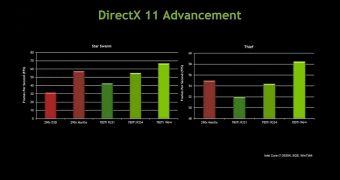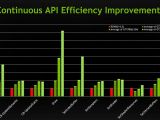During the Game Developers Conference, NVIDIA may have demoed Virtual Hair in The Witcher 3 and spoken about DirectX 12 versus AMD Mantle, but it had one final surprise in store too: a DirectX 11 – AMD Mantle comparison in which Mantle lost.
Well, presumably. There isn't an easy way to actually compare driver improvements and performance gains in application programming interfaces, even when you use the same games as examples.
Fortunately, games can use both Mantle and DirectX, and NVIDIA chose a pair to test the living lights out of.
The slide above shows the benchmark tests one next to the other. The performance of Thief in AMD Mantle mode is compared to the game in DirectX and under the R331 NVIDIA Driver, NVIDIA's R334 Driver (the current driver) and an upcoming driver.
Much to the general surprise (and amazement in some cases) of the ones attending the presentation at GDC 2014, NVIDIA's GeForce GTX 780 Ti won (when the upcoming driver was used), and by a significant amount too, compared to Radeon R9 290X with Mantle active.
As over-the-top as company benchmarks usually are, if NVIDIA claims a huge gain over AMD mantle, then there will probably be a significant gain in real-world tests as well.
An increase of an order of magnitude is registered in DirectDraw alone, and the performance raises in all other areas as well (Samplers, Shaders, Vertex Buffers, etc.).
Granted, the charts are made in a way that highlights the differences. The Star Swarm comparison (because Star Swarm was tested too, not just Thief) has an axis of 0-80 and shows better and better performance on NVIDIA, though not too much higher than Mantle on AMD Radeon R9 290X.
It is higher though. And the Thief benchmark, with its 48 fps to 60 fps axis, means that the performance gain, percentage-wise, is lower than in Star Swarm. Nevertheless, the GTX 780 Ti nonetheless outdoes the R9 290X in Mantle.
No doubt, NVIDIA has been furiously working on the driver ever since AMD announced the Mantle application programming interface last year. Maybe since before that.
It's a sad fact that this revelation, that NVIDIA could always enable a performance rise just through a software update, means that NVIDIA has been deliberately holding out on us, performance-wise. It does explain why it didn't make an API of its own though.
Then again, Advanced Micro Devices could very well be preparing to release a driver update that further increases Mantle performance, maybe for the same time as NVIDIA's launch of this mysterious miracle, so the tables could be turned by the time NVIDIA's mega-driver is released.

 14 DAY TRIAL //
14 DAY TRIAL // 
